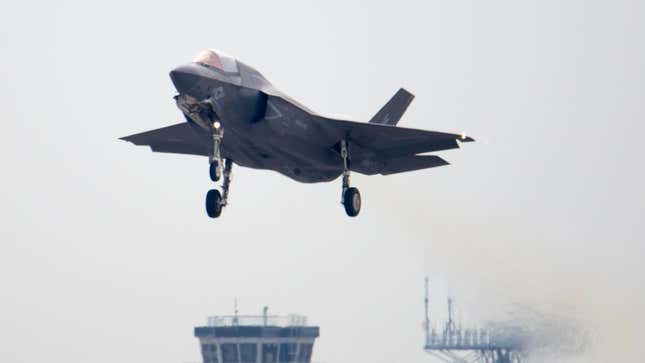
What does it sound like when $100 million crashes into the ground? Beneath the howl of wind and the shouts of bystanders, there’s the roar of the jet engine, and then a sort of scraping sound, as the smooth stealth exterior of the most expensive fighter jet in history grinds along the runway. The F-35B is one of the most sophisticated jets ever built. On the morning of Thursday, December 15, one crashed onto a runway in Fort Worth, Texas, the pilot ejecting as the plane plowed into the soil.
The video, shared with a local CBS affiliate, is visible here:
Most plane-crash videos are terrifying on account of the speed involved. Every airplane is a hubristic attempt to hurl gangly mammals through the sky, and the most dangerous parts of flying are building up speed for takeoff or shedding that speed and altitude on a landing.
In the case of this crash landing, the F-35B almost floats to the ground, a slight wobble before a touch-and-go bounce that sends the nose into the ground and threatens to throw the entire aircraft aft over teakettle. This floating descent is made possible by the careful release of vectored thrust from the jet engine, which angles its nozzle downward, as well as lift from a vertically oriented fan behind the cockpit and side-vented exhaust under the wings. This configuration makes the F-35B a “STOVL” (pronounced Stove-uhl) aircraft, for “Short Take Off Vertical Landing.”
DefenseNews reports that the pilot of the crashed F-35B had no serious injuries and was swiftly released from the hospital. What will likely come next for the military is an assessment of what went wrong in the landing, determining whether the materials or piloting or controls were at fault, and some effort to ensure the same errors do not happen again.
The F-35 line of jets, which includes the Air Force’s F-35A and the Navy’s F-35C, is still in active production. Jets are purchased in lots, with each batch priced somewhat differently as conditions change. Per-jet prices are expected to start increasing again as purchase orders shrink in coming years. The F-35B that crashed in Texas in December may be repairable, or it may be replaced, but it’s not yet a finite loss for the military.
Only in the Department of Defense can a $100 million piece of hardware be seen as a budget rounding error. The Pentagon is set to receive at least $817 billion next year. Every F-35 in that budget is a bet on a specific kind of future war.

The F-35B is designed to operate from Amphibious Assault Ships. These flat-topped vessels would be considered aircraft carriers in the navies of any other nation, but they’re smaller than the massive nuclear-reactor-powered Nimitz- and Ford-class carriers of the U.S. fleet. These Amphibious Assault ships, in the America and Wasp classes, have runways almost 250 feet shorter than their larger brethren, which means they need planes that can operate from shorter runways or land vertically, like the F-35B.
Putting F-35Bs on these carriers lets the Navy and Marine Corps spread out its aircraft, useful for supporting ground invasions from the sea and invaluable when fighting for control over, say, Pacific island chains. Should the United States and China get into a shooting war, and should that shooting war not immediately turn into a cataclysmic nuclear exchange, F-35s, and especially Marine Corps F-35Bs, are designed to be at the heart of that fighting.
The stealth of these jets is useful for evading enemy radar and sensors, though that stealth is diminished whenever the fighters carry weapons mounted on wings or within internal bomb bays. Since World War II, aircraft have been the preferred way to sink hostile ships, though missiles fired from ships or batteries on land can also do real damage to a fleet. Carriers and planes let a fleet disperse its weapons and strike far beyond the horizon, and ideally facilitate the safe return of personnel to fight again another day.
None of that matters if the planes cannot safely land. While Forth Worth experienced some gusts of up to 25 mph on December 15th, such weather should not be a major obstacle to flight. In 2022, one of each type of F-35 crashed. Last January, a Navy F-35C was lost in the South China Sea while attempting a landing on an aircraft carrier (it was later recovered). In October, an F-35A crashed in Utah.
The F-35 is, ultimately, a plane the Department of Defense is stuck with, a purchase at volume that replaces many aging types of fighters, designed to serve the military for decades to come. Perhaps the investigation into December’s mishap will reveal a fixable problem, preventing the same kind of error from repeating.
On January 4, Aviation Week reported that a technical fault has been identified as a possible contributor to the crash. A longer investigation into how the crash happened, and what can be done in the future, is underway.
What cannot be determined, at least not in the sterile writing of a crash assessment, is what else the $100 million spent on that wrecked jet might have gone towards instead. Nor will that crash report determine whether the security of people in the US is really enhanced by a superjet that goes wibbly-wobbly in a stiff breeze.
Kelsey D. Atherton is a military technology journalist based in Albuquerque, New Mexico. His work has appeared in The New York Times, Popular Science, Slate, and elsewhere.
